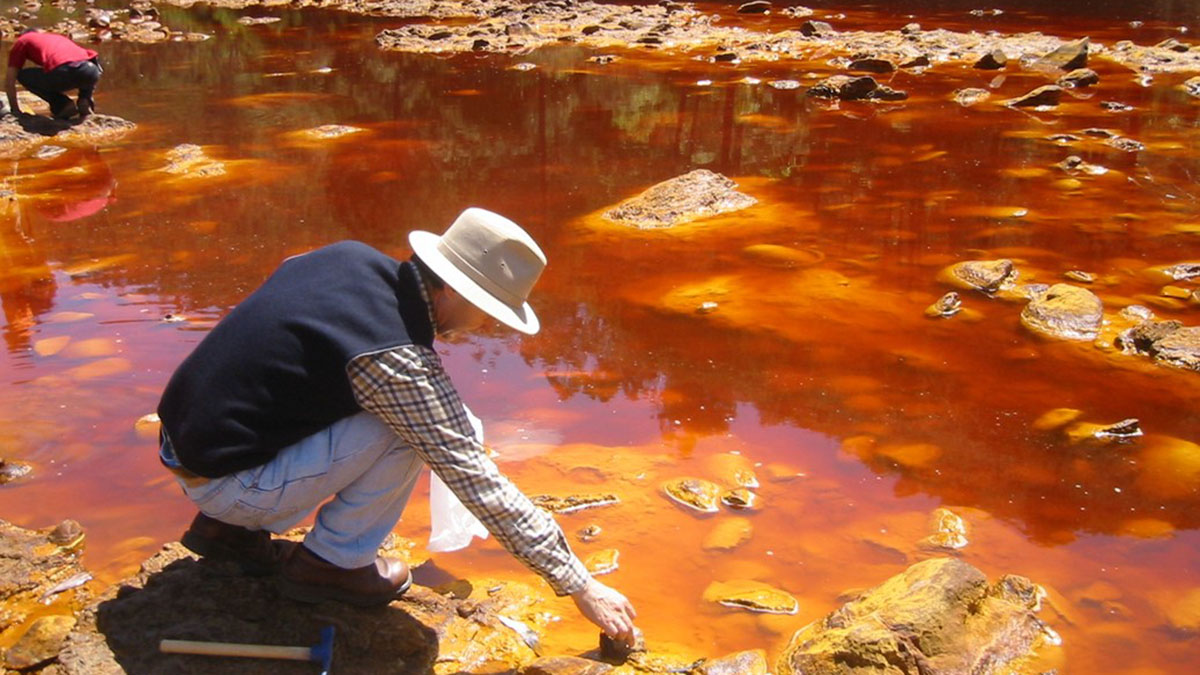Editors’ Vox is a blog from AGU’s Publications Department.
Magnetic minerals, typically iron oxides and some iron sulfides, preserve a record of the ancient magnetic field of planetary bodies and, as such, carry a wealth of geoscientific information. Hematite (ferric iron oxide) is a common magnetic mineral on Earth and Mars. In addition to registering the paleomagnetic field, it carries information about ancient climates and environments. Well-dated terrestrial hematite enables detailed monsoon reconstructions, while hematite occurrences on Mars tend to be associated with the former presence of water. Hence, hematite-bearing regions are considered key to the search for potential ancient life on Mars.
A recent article in Reviews of Geophysics describes the magnetic and color properties of terrestrial hematite—where both sets of properties help to identify and interpret signals due to hematite. Here, the authors give an overview of the importance of hematite on Earth and Mars.
What is hematite and where is it most commonly found?
Hematite (a-Fe2O3) is an iron oxide that derives its name from the Greek haimatite, meaning blood-like, which refers to its distinctive red color. Hematite occurs widely on Earth, Mars, the Moon, and some asteroids. On Earth, hematite is abundant in aerobic tropical and subtropical soils and sediments, loosely referred to as red beds; i.e., it reflects warm and humid climates.
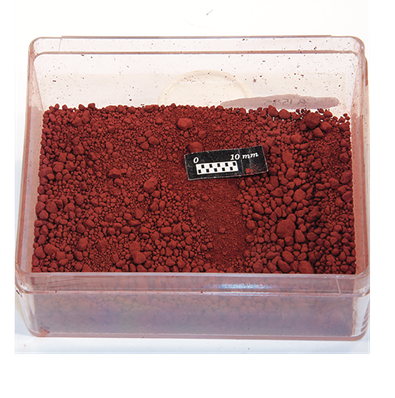
Hematite also occurs in Archean and Paleoproterozoic (4 to 1.6 billion years ago) sedimentary banded iron formations that record the evolution of Earth’s early atmosphere and ocean.
Moreover, hematite is the dominant pigment in oceanic red beds, which are reddish to pinkish marine sedimentary rocks deposited in the open sea far out of the coast that document global oceanic and climate changes during the Cretaceous greenhouse world.
High pressure and temperature experiments on hematite and its polymorphs suggest that they can be dominant magnetic signal carriers down to depths of ~600 km in (cold portions of) subducted slabs under conditions where the archetypical terrestrial magnetic mineral, magnetite (Fe3O4), has decomposed thermally.
Hematite is the most common pigmenting mineral on the surface of Mars, and its nickname as the “Red Planet” is due to hematite. Hematite on Mars occurs in three forms with different properties: nanophase, red crystalline, and gray crystalline hematite. The former two are the dominant contributors to the eye-catching reddish color of the bright regions of Mars.
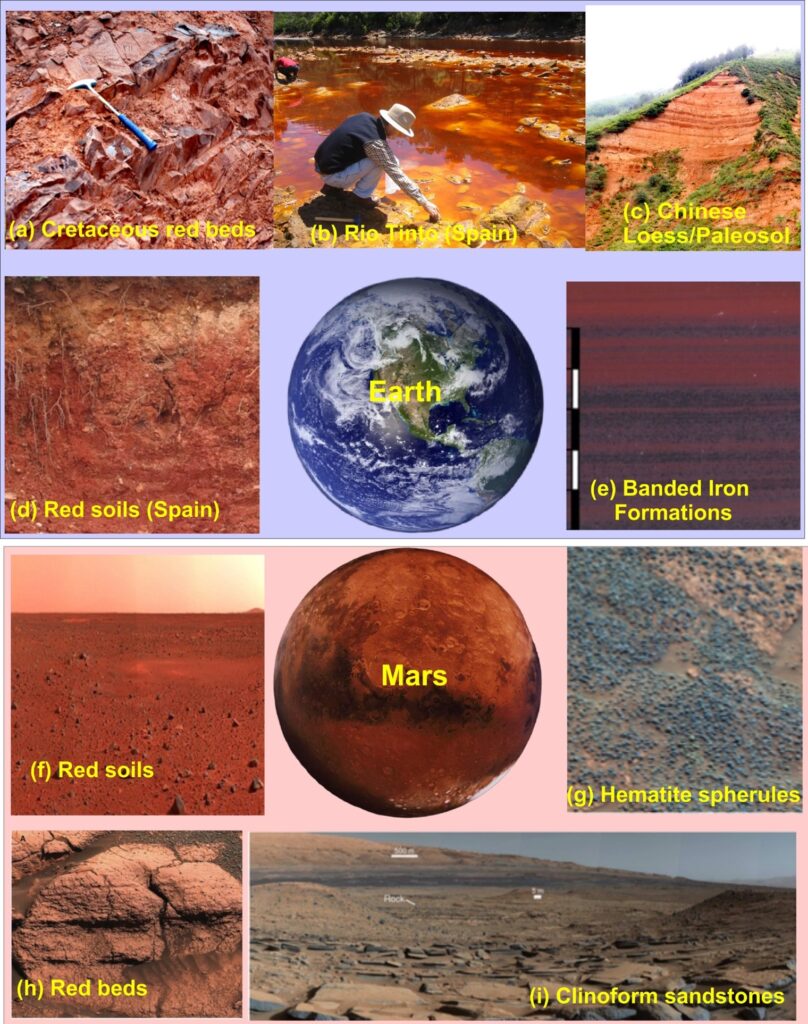
How can hematite be used to understand paleoclimate variations over time?
Hematite formation is controlled by several geologic processes. For example, compared to other magnetic minerals, hematite is more abundant in subtropical and tropical soils that experience frequent prolonged dry episodes. Therefore, hematite content variations may indicate paleoclimate variations.
Additionally, hematite in some marine sediments is dominantly transported as dust from inland by wind (e.g., monsoon or westerlies). Stronger winds transport more dust and, thus, more hematite into the oceans. Evolution of monsoon systems or westerlies may be tracked by the hematite content in wind-blown sediments.
Additionally, soils with near-neutral pH and low organic content tend to favor hematite formation over goethite (a-FeOOH). So, the hematite to goethite ratio (Hm/Gt) can provide important soil moisture information related to climate change unless either phase is dissolved reductively.
Therefore, hematite abundance is an important proxy in studies of geologic and environmental processes.
What is cation substitution and how does it affect the physical properties of hematite?
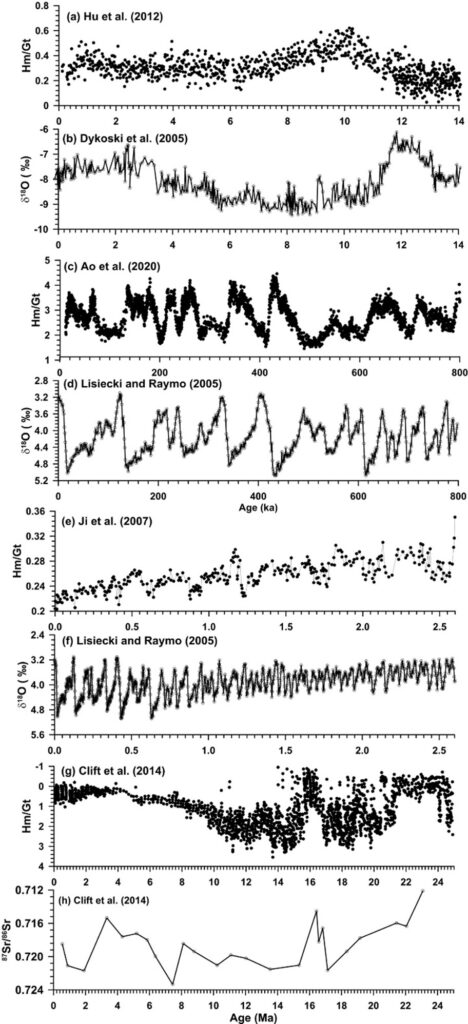
Cations other than Fe3+ (e.g., Al3+, Ti4+, Mn2+) are always present to some extent in natural hematite. They are incorporated easily into the hematite crystal lattice by substituting for Fe.
For example, Al-substituted hematite occurs widely in Al-rich tropical and subtropical soils, e.g., in Brazil and South Africa. In such warm and humid environments, Al is incorporated into iron oxides during chemical weathering, so Al-hematite typically is associated with soil origin.
Fe3+ and Al3+ have a different ionic radius (Fe3+: 0.65 Å; Al3+: 0.53 Å), so the symmetrical octahedral hematite structure becomes distorted when Al substitution occurs, which enhances internal strain. Al-hematite particles are also smaller. These differences cause the magnetic properties of Al-substituted hematite to differ from unsubstituted hematite.
Non-magnetic Al ions are incorporated randomly into the hematite lattice, so Fe ions are diluted, which decreases the magnetism of hematite with increasing Al content, i.e., themagnetic susceptibility (c, the magnetic moment of a sample in a low, Earth-like, magnetic field) and saturation remanent magnetization (Mrs, the maximum possible permanent magnetic moment after exposure to a high magnetic field) go down. In addition, with increasing Al content, the color of hematite becomes lighter red, so the characteristic peak position and amplitude of color reflectance spectra will change correspondingly.
These variable properties are crucial for identifying hematite and its cation-substituted counterparts on Earth and Mars.
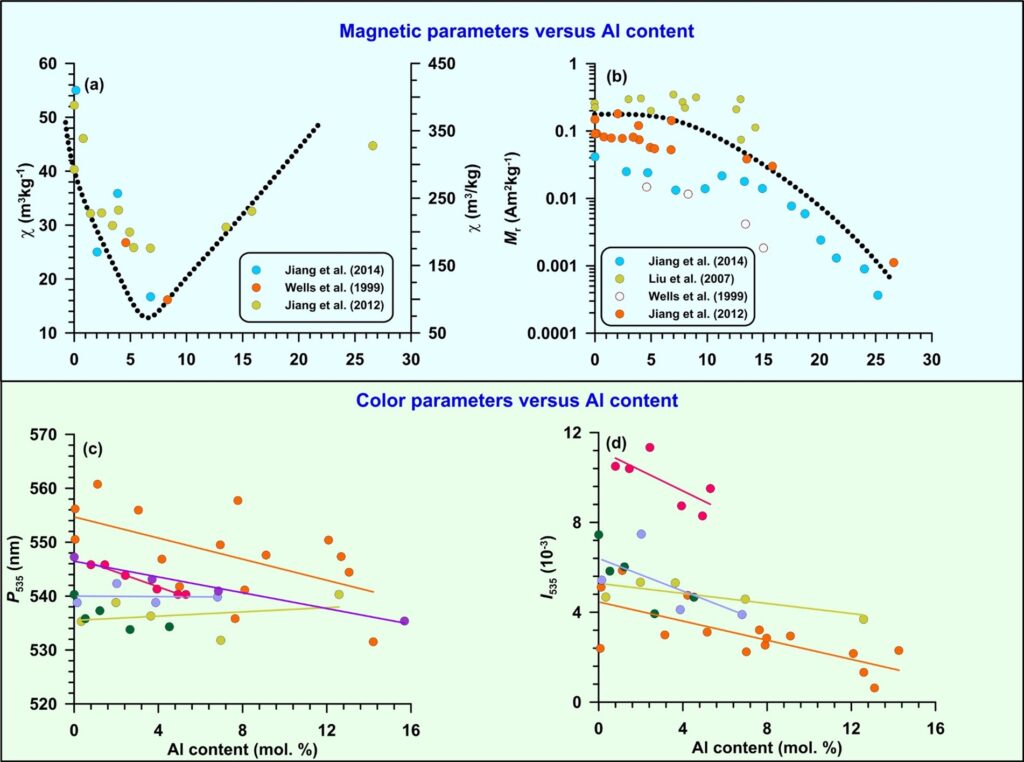
What is remagnetization and how does it complicate the paleomagnetic record?
The natural remanent magnetization (NRM, a rock’s registration of the prevailing geomagnetic field at a given time) of a remagnetized rock represents a much younger age than that of the host rock. Thus, remagnetization complicates paleomagnetic data interpretation of rocks, soils, and sediments.
Typically, remagnetization mechanisms may involve several pathways: 1) magnetic mineral transformations associated with redox processes, i.e. formation of magnetite (Fe3O4), greigite (Fe3S4), or pyrrhotite (Fe7S8); 2) deformation-associated fluid migration and/or pressure solution; 3) chemical weathering in moist, tropical environments; or 4) the resetting of existing NRM by prolonged exposure to a stable geomagnetic field at moderately elevated temperatures (~100-250 °C), so called thermoviscous remanent magnetization acquisition.
Acquisition of secondary NRM through any of these mechanisms will obscure the primary paleomagnetic record and may lead to inaccurate paleomagnetic interpretations if not recognized. Therefore, discriminating between primary and secondary remanence is central to paleomagnetic studies. Unfortunately, widespread remagnetizations carried by hematite have been documented, especially in red beds.
How can terrestrial hematite be used to better understand the geology of Mars?
Understanding the origin of Martian hematite is essential to unravel its geologic history and to answer the question of whether liquid water was present on Mars. Possibly, hematite may even unveil its climatic history.
Martian samples are extremely scarce (essentially only from Martian meteorites). This makes it difficult to investigate hematite formation on Mars, so we must rely for now on relevant Earth analogs.
Hematite can form by several mechanisms, most of which involve water. Understanding hematite formation pathways is critical for interpreting information carried by hematite in terms of climate, environment, tectonics, and planetary evolution.
Although a fully defined hematite formation pathway has yet to be discerned for Mars, the origin of crystalline hematite can provide chemical clues about the early Martian environment, especially pertaining to the existence of (liquid) water, which is an indispensable requirement for evolution and sustenance of life.
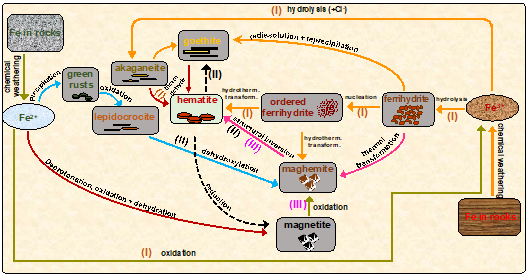
What are some of the unresolved questions where additional research, data, or modeling is needed?
Although terrestrial hematite has been investigated systematically, the scarcity of Martian meteorite samples makes it difficult to investigate hematite from Mars. Systematic studies of the properties of terrestrial hematite are indispensable to provide an interpretive framework for Martian hematite. However, hematite properties are complex and depend critically on formation conditions.
Key questions are: how comparable is hematite on Earth and Mars? Is hematite on Mars cation-doped? If so, how can cation content be quantified? Can this be done with color reflectance measurements? A robust database of these hematite properties on Earth and Mars is required to inform such questions along with a full understanding of its formation mechanisms.
Integrated analysis should provide meaningful reference data for future studies of Martian soils or rocks. For example, by comparing with Al-substituted terrestrial reference hematite, it may be deduced whether hematite on Mars is also Al-substituted. This will provide necessary ground-truthing for spectral and other remote Martian surface observations.
—Zhaoxia Jiang ([email protected], ![]() 0000-0003-0860-9753), Ocean University of China, China; and Qingsong Liu, Southern University of Science and Technology, China; Andrew Roberts, Australian National University, Australia; Mark J. Dekkers, Utrecht University, The Netherlands; Vidal Barrón, University of Córdoba, Spain; José Torrent, University of Córdoba, Spain; and Sanzhong Li, Ocean University of China, China
0000-0003-0860-9753), Ocean University of China, China; and Qingsong Liu, Southern University of Science and Technology, China; Andrew Roberts, Australian National University, Australia; Mark J. Dekkers, Utrecht University, The Netherlands; Vidal Barrón, University of Córdoba, Spain; José Torrent, University of Córdoba, Spain; and Sanzhong Li, Ocean University of China, China

